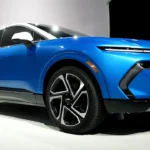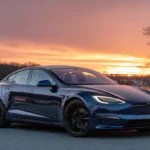Electric Air Taxis
When the Federal Aviation Administration finalised its “powered-lift” rule in October 2024, it effectively unlocked the nation’s sky lanes for electric vertical-take-off-and-landing aircraft—better known as air taxis. Eight months later, in June 2025, the agency went a step further, joining regulators in Australia, Canada, New Zealand, and the UK to publish a joint certification roadmap aimed at fast-tracking commercial approvals. For commuters marooned in gridlock, that bureaucratic progress could soon translate into seven-minute, zero-emission hops between urban rooftops and major airports.
1. From Blueprint to Lift-Off: The First FAA Test Flights
California-based Joby Aviation became the poster child for the new era when it completed multiple piloted transition flights—vertical take-off, wing-borne cruise, and vertical landing—in April 2025. Just weeks later the company flew two aircraft simultaneously, demonstrating the fleet operations regulators will eventually require. In January the same year, Joby entered the FAA’s Type Inspection Authorization (TIA) phase, the last stop before full type certification.
Rival Archer Aviation is not far behind. It secured an FAA-recognised Part 141 pilot-training certificate in February 2025, laying the groundwork for a pipeline of qualified eVTOL pilots ahead of first passenger service.
2. Why the Green Light Matters for Daily Commutes
Delta Air Lines, a strategic investor in Joby, loves to cite a vivid example: the slog from Westchester County to JFK Airport can swallow two hours by car, yet Joby says an air-taxi hop would take just 15 minutes. Similar math applies to Silicon Valley–San Francisco and London–Heathrow. If ticket prices settle near premium-car-service levels, the time savings alone could flip commuters from road to sky—and relieve pressure on choked expressways.
3. Tech Specs That Make the Concept Plausible
Modern eVTOLs marry six to twelve rotors for whisper-quiet vertical lift with a fixed wing for 200 mph cruise. Joby’s FAA-conforming prototype logs 100-mile range on a single charge, enough to cover 99 percent of trips within New York City’s five boroughs. Battery swaps or six-minute DC fast-charges during passenger turn-arounds keep utilisation high, while noise levels register far below those of conventional helicopters.
4. Economics: From Helicopter Luxury to Mass-Market Option
Helicopter shuttles once cost hundreds of dollars per seat. By exploiting electric powertrains, lightweight composites, and fewer moving parts, operators project costs-per-mile on par with ride-share vans. Joby and Archer forecast $3–4 per passenger-mile at scale, roughly taxi fare in many U.S. cities. Investors are betting those numbers can unlock a multi-billion-dollar urban air-mobility market within a decade.
5. Infrastructure Is Catching Up
Vertiport designs from Skyportz and Jetex propose modular, parking-lot-sized pads with rapid-charge stations and minimal perimeter setbacks. Municipalities like Los Angeles, Miami, and Dubai have issued preliminary site permits, aiming for a skeleton network by the 2026 FIFA World Cup. Meanwhile, Archer’s partnership with Jetex will upgrade existing private-jet terminals to handle eVTOL traffic.
6. Remaining Hurdles
Certification is a five-step marathon; Joby is deep into stage 4, while Archer eyes completion in Q3 2025.Air-traffic-management software must integrate thousands of daily low-altitude flights without burdening controllers. Public acceptance, too, will hinge on demonstrated safety and low noise. And although the FAA’s new rule clarifies pilot licensing, large-scale infrastructure approvals still rest with city councils and neighbourhood groups.
7. The 2025 Outlook
By the end of this year, expect the first FAA-piloted flight tests of fully conforming aircraft. Service launches in Los Angeles, New York, and Dallas could follow in late 2026, with Dubai and Tokyo potentially debuting earlier thanks to more streamlined regulatory paths abroad. If timelines hold, commuters might soon hail an air taxi as casually as they tap a ride-share app.
Bottom line: Electric Air Taxis Granted FAA Test Flights—Could They Disrupt Urban Commutes? The answer looks increasingly like “yes.” With regulatory hurdles falling, pilots in the cockpit, and vertiports on city planners’ agendas, 2025 is shaping up as the pivotal year when urban air mobility left the drawing board and entered real airspace.
Read more: 5 Game-Changing Highlights in GM’s Ultium Update: New Plants, New Chemistries, New Range Records









